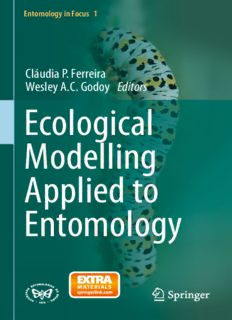
Ecological Modelling Applied to Entomology PDF
Preview Ecological Modelling Applied to Entomology
Entomology in Focus 1 Cláudia P. Ferreira Editors Wesley A.C. Godoy Ecological Modelling Applied to Entomology Entomology in Focus Volume 1 SeriesEditor FernandoL.Cônsoli Piracicaba,Brazil This series features volumes of selected contributions from workshops and con- ferences in all areas of current research activity in applied mathematics. Besides an overall evaluation, at the hands of the publisher, of the interest, scientific quality, and timeliness of each proposal, every individual contribution is refereed tostandardscomparabletothoseofleadingmathematicsjournals.Thisseriesthus proposestotheresearchcommunitywell-editedandauthoritativereportsonnewest developmentsinthemostinterestingandpromisingareasofmathematicalresearch today. Moreinformationaboutthisseriesathttp://www.springer.com/series/10465 Cláudia P. Ferreira • Wesley A.C. Godoy Editors Ecological Modelling Applied to Entomology 123 Editors CláudiaP.Ferreira WesleyA.C.Godoy DepartamentodeBioestatistica DepartamentodeEntomologiaeAcarologia InstitutodeBiociências EscolaSuperiordeAgricultura UniversidadeEstadualPaulista “LuizdeQueiroz” Botucatu,SãoPaulo,Brazil UniversidadedeSãoPaulo Piracicaba,SãoPaulo,Brazil Additionalmaterialtothisbookcanbedownloadedfromhttp://extras.springer.com ISBN978-3-319-06876-3 ISBN978-3-319-06877-0(eBook) DOI10.1007/978-3-319-06877-0 SpringerChamHeidelbergNewYorkDordrechtLondon LibraryofCongressControlNumber:2014953586 ©SpringerInternationalPublishingSwitzerland2014 Thisworkissubjecttocopyright.AllrightsarereservedbythePublisher,whetherthewholeorpartof thematerialisconcerned,specificallytherightsoftranslation,reprinting,reuseofillustrations,recitation, broadcasting,reproductiononmicrofilmsorinanyotherphysicalway,andtransmissionorinformation storageandretrieval,electronicadaptation,computersoftware,orbysimilarordissimilarmethodology nowknownorhereafterdeveloped.Exemptedfromthislegalreservationarebriefexcerptsinconnection with reviews or scholarly analysis or material supplied specifically for the purpose of being entered and executed on a computer system, for exclusive use by the purchaser of the work. Duplication of this publication or parts thereof is permitted only under the provisions of the Copyright Law of the Publisher’slocation,initscurrentversion,andpermissionforusemustalwaysbeobtainedfromSpringer. PermissionsforusemaybeobtainedthroughRightsLinkattheCopyrightClearanceCenter.Violations areliabletoprosecutionundertherespectiveCopyrightLaw. Theuseofgeneraldescriptivenames,registerednames,trademarks,servicemarks,etc.inthispublication doesnotimply,evenintheabsenceofaspecificstatement,thatsuchnamesareexemptfromtherelevant protectivelawsandregulationsandthereforefreeforgeneraluse. While the advice and information in this book are believed to be true and accurate at the date of publication,neithertheauthorsnortheeditorsnorthepublishercanacceptanylegalresponsibilityfor anyerrorsoromissionsthatmaybemade.Thepublishermakesnowarranty,expressorimplied,with respecttothematerialcontainedherein. Printedonacid-freepaper SpringerispartofSpringerScience+BusinessMedia(www.springer.com) Preface In recent decades, entomologists have expanded their analytical tools to improve the interface between population theory and ways to analyse and interpret results in research programs that emphasise mathematical modelling. Entomology is a fruitful area for investigating complex processes and dynamic systems due to the biological characteristics exhibited by insects. They experience different life phases, frequentnotable interactions, and are classified by intraspecific to trophic relationships with different degrees of association. The Neotropical ecozone is one of the eight major zoogeographicalareas of the world, which contains about a third of the world’s insects that live in complex topographical environments. This condition likely allowed these organisms to experience different levels of adaptation to face the diversity of factors influencing their demography. The changesthatoccurredintheseenvironmentshavesubstantiallyalteredtheresource sourcesforinsects,especiallyfoodavailability.Thepredominanceofmonocultures in Neotropical areas has remarkably impacted the environment and substantially changedthestructureofinsectfaunabyprovidingsuitableconditionsforinfestation by pests. Accelerated urbanisation processes have also negatively impacted the urbanscenarios,includinggivingrisetotheemergenceofinfra-structuralproblems inthemetropolisandinducingtheproliferationofvectorinsectsofseriousdiseases. Given the extensive problems facing humanity, we live in what could be called the era of challenge and exploding information. Concurrently, thanks to growing interestindevelopingmodels,ampleopportunitiestogenerateandexploredatahave quicklybeencreatedbytheorists,statisticiansandentomologists,whocananalyse data with precise tools, particularly when ecological methodologies are applied to entomology. The computational resources currently available are far superior to what was available in the past, thus allowing bold designs that can consider space and time simultaneously, especially in interface areas such as ecological modelling. The use of mathematical models to describe ecological processes and predict tendencies has been increasing in the last decades in response to growing demandforanalyticaltoolsthatarecompatiblewithemergingissuesintheprevious v vi Preface and current centuries. Comprehending basic population or community functions usingecologicalformalismcanleadtousefulmodelsembeddedinecologicaltheory thatarecapableofcoveringawidespectrumofissues,rangingfromspatio-temporal ecologicalpatternsofpopulationsand/orcommunitiestoepidemiologicalaspectsor trophicwebs.Thisisapioneeringworkinaspecificareawithinterestinginterfaces forpeopleinterestedininterdisciplinarystudies.We hopethatitwillbeusefulfor a significant number of researchers and students involved with insect population dynamics emphasising pest management and conservation. The authors of this book thank Fundação de Amparo à Pesquisa do Estado de São Paulo FAPESP andConselhoNacionaldeDesenvolvimentoCientíficoeTecnológicoCNPqforthe supportwiththeresearchprojects. Botucatu,SP,Brazil ClaudiaP.Ferreira Piracicaba,SP,Brazil WesleyA.C.Godoy Contents 1 InsectsandtheEcologicalBasisforMathematicalModelling.......... 1 ClaudiaP.FerreiraandWesleyA.C.Godoy 2 Demographic Processes in Spatially StructuredHost-ParasitoidSystems....................................... 11 CarolinaReigada, MarcusAloizioMartinezdeAguiar, andLucasDiasFernandes 3 AbioticEffectsonPopulationDynamicsofMosquitoes andTheirInfluenceonDengueTransmission ............................ 39 HyunMoYang, JoséLuizBoldrini, ArturCesarFassoni, KarlaKaterineBarbozadeLima, LuizFernandoSouzaFreitas, MillerCeronGomez, ValmirRobertoAndrade,andAndréRicardoRibasFreitas 4 Modelling theImplicationsofTemperatureontheLife CycleofAedesaegyptiMosquitoes ......................................... 81 MarceloMargonRossi,LêudaÓlivêr,andEduardoMassad 5 Predictive Modelling of Insect Metacommunities inBiomonitoringofAquaticNetworks.................................... 109 TadeuSiqueira, LucasDaniloDurães, andFabiodeOliveiraRoque 6 ModelingTrophicInteractionsinInsectPopulationDynamics ........ 127 MichelIskindaSilveiraCostaandLucasDelBiancoFaria 7 CoupledMapLatticeModelforInsectsandSpreadable Substances .................................................................... 141 Luiz Alberto D. Rodrigues, Maria C. Varriale, WesleyA.C.Godoy,andDiomarC.Mistro vii viii Contents 8 ComputationalMethodsforAccurateEvaluationofPest InsectPopulationSize ....................................................... 171 NataliaPetrovskayaandNinaEmbleton 9 ModelsforOverdispersedDatainEntomology .......................... 219 ClariceG.B.Demétrio,JohnHinde,andRafaelA.Moral Index............................................................................... 261 Chapter 1 Insects and the Ecological Basis for Mathematical Modelling ClaudiaP.FerreiraandWesleyA.C.Godoy Abstract This book brings together nine chapters that aim to present the most recentresearchontheinterfacebetweenecologicalmodellingandentomology.The chapters are summaries of research performed in different Brazilian institutions, UK and Ireland universities. The idea of the book is to present different focuses of study by aggregating theoretical ecology and applications in agricultural and medical entomology, also emphasising pest management and conservation. This chapterbrieflysummarisesahistoryofthepopulationtheoryappliedtoentomology andwillintroducethereadertothetopicsdevelopedinthefollowingchapters. Keywords Entomology • Insectpopulationmodelling 1.1 Introduction Insects are fascinating organismsthat have suffered evolutionaryadaptationsover geologic periods. Their extraordinary stages of evolution have provided them with special characteristics to occupy different habitats and to face a variety of environmentalconditions(Carpenter1953).Duetothisflexibility,insectshavebeen abletodevelopspecificabilitiesandstrategiesforexploitingresourcestoguarantee their survival even in adverse conditions. They are advantageous to humans in variouscontexts.Forexample,thereareinsectspeciesthatactasnaturalenemiesof pests,thatyieldproductsbeneficialtohumans,suchasthehoneybeeandsilkworm, and that can be used as forensic indicators,biotherapyand food (Goldsmith et al. 2005; Parnés and Lagan 2007; Wells and Stevens 2008; Srinivasan 2010; van Huis2012).However,althoughtheseorganismsexhibitinterestingmechanismsof C.P.Ferreira DepartamentodeBioestatistica,InstitutodeBiociências,UniversidadeEstadualPaulista, Botucatu,SãoPaulo,Brazil e-mail:[email protected] W.A.C.Godoy((cid:2)) DepartamentodeEntomologiaeAcarologia,EscolaSuperiordeAgricultura “LuizdeQueiroz”,UniversidadedeSãoPaulo,Piracicaba,SãoPaulo,Brazil e-mail:[email protected] ©SpringerInternationalPublishingSwitzerland2014 1 C.P.Ferreira,W.A.C.Godoy(eds.),EcologicalModellingAppliedtoEntomology, EntomologyinFocus1,DOI10.1007/978-3-319-06877-0__1
Description: